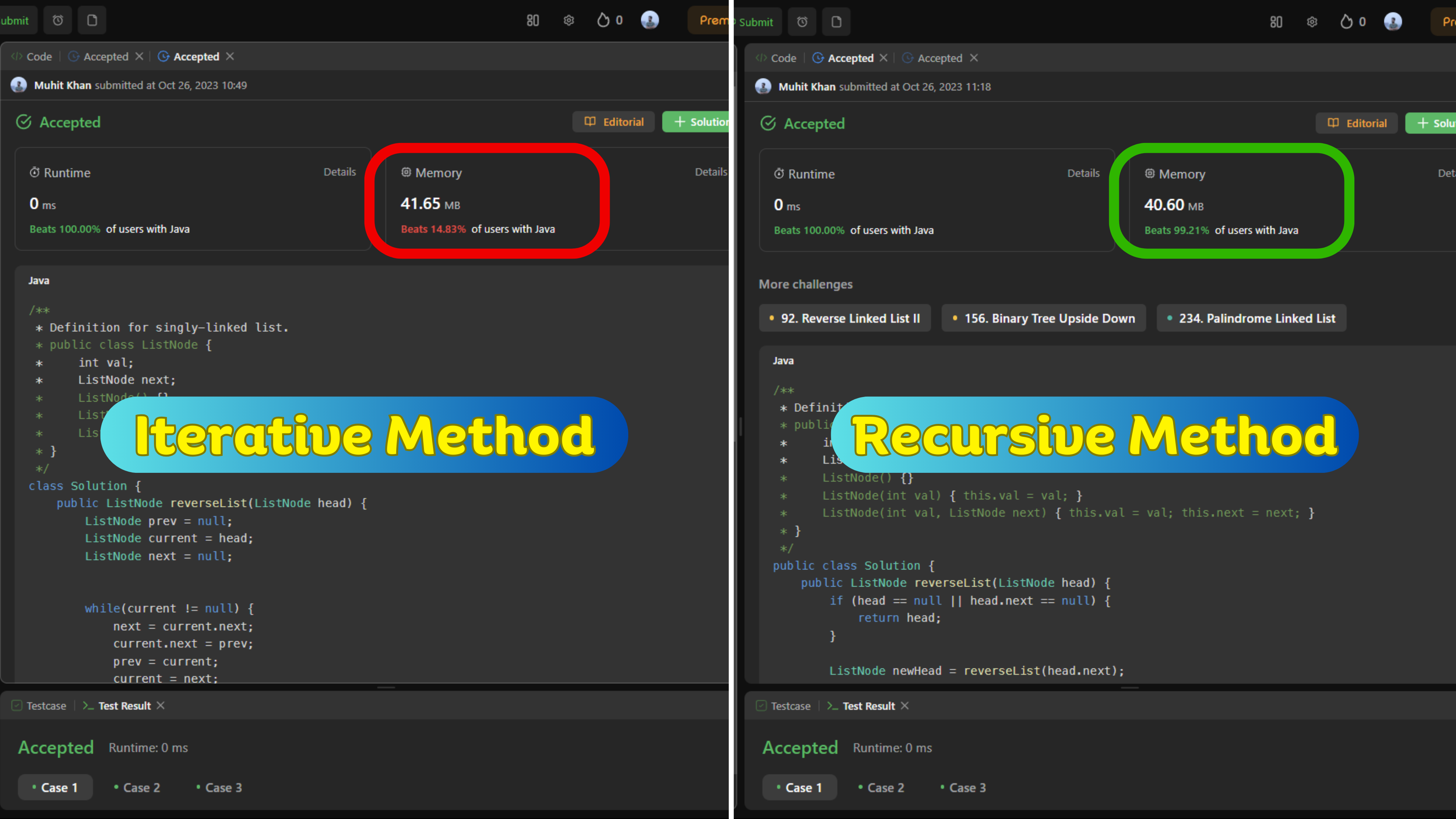Battle of the Algorithms: Loop vs. Recursion in Reversing Linked Lists
 Muhit Khan
Muhit Khan
Reversing a linked list is a classic problem in the realm of programming interviews and data structure manipulation. It seems like a simple task, but the way you tackle it can significantly impact your code's efficiency and resource consumption. In this tech blog, I'm going to dissect two popular solutions for reversing a linked list: one using a loop and the other leveraging recursion. Buckle up as we embark on a journey to compare the pros and cons of each approach.
The Problem at Hand:
Imagine we're given a singly linked list, and our mission is to reverse it while returning the reversed list. Let's illustrate this problem:
Input: [1, 2, 3, 4, 5]
Output: [5, 4, 3, 2, 1]
Solution 1: Iterating Through the List(Loop)
class Solution {
public ListNode reverseList(ListNode head) {
ListNode prev = null;
ListNode current = head;
ListNode next = null;
while (current != null) {
next = current.next;
current.next = prev;
prev = current;
current = next;
}
return prev;
}
}
Solution 2: Recursion Rocks
public class Solution {
public ListNode reverseList(ListNode head) {
if (head == null || head.next == null) {
return head;
}
ListNode newHead = reverseList(head.next);
head.next.next = head;
head.next = null;
return newHead;
}
}
Time and Space Complexity Showdown
Both of these solutions have a time complexity of O(n), where n is the number of nodes in the linked list. The twist comes in when we analyze their space complexities.
Solution 1: Loop
Time Complexity: O(n)
Space Complexity: O(1)
Solution 2: Recursion
Time Complexity: O(n)
Space Complexity: O(n)
When it comes to memory usage, Solution 1 with its loop cruises along efficiently with a constant space complexity of O(1). In contrast, Solution 2, being the recursive diva, demands a space complexity of O(n) due to its function call stack.
As we all know, the common practice is to choose the approaches with Constant complexity over the approaches with other complexities. Absolutely, this practice is reasonable considering the use of a larger dataset and graph of time/space vs Input size. But in the real world situations may lead us to different conclusions.
Performance Analysis Upon LeetCode Submissions
Let's step into the real world of code submissions on LeetCode and see how these solutions fare. There are some striking differences, especially in memory usage.
Solution 1 using Iteration/Loop
Runtime: 0ms
Memory: 41.65MB
Memory Ranking: beats 14.83% of Java users
Solution 2 using Recursion
Runtime: 0ms
Memory: 40.60MB
Memory Ranking: beats 99.21% of Java users
Choosing the Right Weapon
The decision between Solution 1 and Solution 2 isn't a one-size-fits-all scenario. Your choice should depend on your project's requirements or the constraints of the problem you're solving. Looping or iterating (Solution 1) generally stands as the memory-efficient champion, particularly for handling substantial datasets. On the flip side, recursion (Solution 2) is more intuitive and often simpler to implement, making it an excellent choice for smaller datasets or situations where code readability reigns supreme.
In the end, the selection between these two approaches hinges on the context and constraints of your specific problem. As a developer, having an array of techniques in your toolbox is essential, as you never know when you'll need to decide between an efficient, memory-saving loop or an elegant, recursive solution.
Subscribe to my newsletter
Read articles from Muhit Khan directly inside your inbox. Subscribe to the newsletter, and don't miss out.
Written by

Muhit Khan
Muhit Khan
Coding The Way to Tomorrow